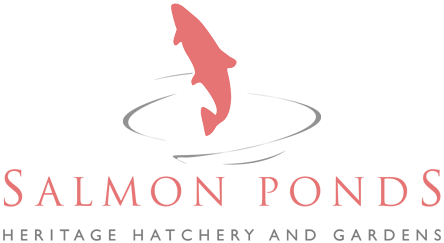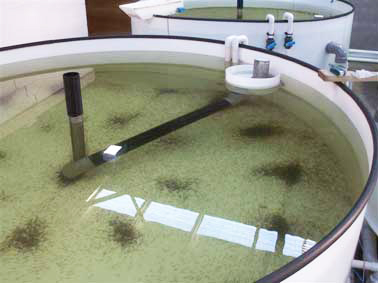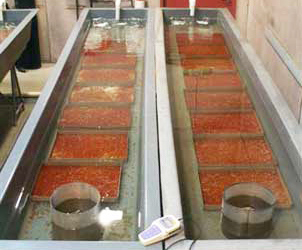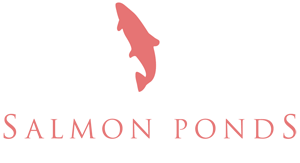

The Historic & Modern Hatcheries
For more than a century the Salmon Ponds has stocked Tasmania’s lakes and dams with over one million trout each year. Today, amongst some of its original buildings and trees, this site continues its function as a hatchery, fulfilling part of the hatching process.
The need to enhance fish rearing facilities was identified as far back as the 1940’s when the then Inland Fisheries Commission acknowledged that the Salmon Ponds (and other hatcheries it maintained then) were experiencing difficulties in providing fish of adequate size and health.
 The combination of low water flows and reduced water quality at the Ponds resulted in production being limited largely to fry, with most fish needing to be stocked by December each year to avoid high summer water temperatures. This led to poor and unreliable returns from stockings and a reliance on the support of commercial hatcheries to assist in providing domestic stock in recent years.
The combination of low water flows and reduced water quality at the Ponds resulted in production being limited largely to fry, with most fish needing to be stocked by December each year to avoid high summer water temperatures. This led to poor and unreliable returns from stockings and a reliance on the support of commercial hatcheries to assist in providing domestic stock in recent years.
The Inland Fisheries Service set about addressing this issue with the focus on stocking waters with larger fish during cooler months in order to improve the survival rates of stocked fish. In order to grow adequate numbers of fish to an appropriate size and condition to achieve the best outcome for the fishery, the Service decided to build a 25 tonne intensive recirculation system capable of growing 500,000 fish per annum. The new hatchery was built in New Norfolk in 2007.
Hatchery Design
 The system is comprised of four 10,000 litre and twelve 2,500 litre tanks with the total water volume of the hatchery – including the hatchery room, bio-filter and sumps – in the vicinity of 100,000 litres. This is a fraction of the capacity required for a flow through operation like the Salmon Ponds. The technology is state of the art and well proven, it reduces reliance on water resources, can use mains supply water and is connected to the sewer for waste disposal.
The system is comprised of four 10,000 litre and twelve 2,500 litre tanks with the total water volume of the hatchery – including the hatchery room, bio-filter and sumps – in the vicinity of 100,000 litres. This is a fraction of the capacity required for a flow through operation like the Salmon Ponds. The technology is state of the art and well proven, it reduces reliance on water resources, can use mains supply water and is connected to the sewer for waste disposal.
In simple terms, the water is “recirculated” – recycled and re-used in a loop. Initially, clean water is passed through the fish tanks and troughs in the hatchery and then the dirty water is treated – firstly by passing it through a drum filter to remove uneaten food and solid waste, and secondly through a biological filter, which removes nitrogenous waste produced by the fish. A proportion of the water is also UV treated, super saturated with oxygen and cooled if necessary and then returned to the tanks.
An egg sorter, fish pump, grader and counters have also been installed, further increasing its efficiency.
The Daily Round at The Salmon Ponds
- Cleaning the screens in each pond. A big job in autumn because of deciduous leaves.
- Feeding the fish. The fish are fed each morning with specially formulated pellets.
- Checking the water temperature. Ranges from 4°C in winter to 21°C in summer.
- Removing dead fish. The main causes of death are old age and disease.
A year in the hatching process
Eggs, largely collected from wild trout, are hatched and raised until the fish are between the size of a match (called fry) and a finger (fingerlings). These fish are then released into lakes and dams around Tasmania.
May
Brown trout ova are collected at the annual ‘Open Weekend’ at the Inland Fisheries Service field station at Liawenee in the Central Highlands. Brook trout ova are collected from Salmon Ponds display stock and the pond drained and cleaned.
June

Ova are incubated in the hatchery. Brown trout ova are placed in buckets. Brook trout ova are placed on trays.
July – Hatching time!
August
The young fish are growing on their yolk sacs. Towards the end of the month, fish are ‘bagged up’ and delivered to an angling club rearing unit in the North of the state. At the unit they ‘grow on’ to improve their chance of survival before release.
September
Rainbow trout spawn in spring, so this is the time when their pond is drained. Ova are collected from wild rainbows at Liawenee and other places.
October, November & December
Growing fish require frequent feeding, disease diagnosis and treatment, plus size grading. Despatching fish for stocking lakes and dams continues. By the end of December the troughs in the hatchery are empty.
December to April
Fish management decreases, while visitor numbers increase. Preparations begin in the hatchery for the arrival of the New Year’s ova. The cycle is about to begin once again.
